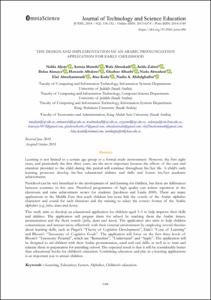Mostra el registre d'ítem simple
The design and implementation of an Arabic pronunciation application for early childhood
| dc.contributor.author | Aljojo, Nahla |
| dc.contributor.author | Munshi, Asmaa |
| dc.contributor.author | Almukadi, Wafa |
| dc.contributor.author | Alanaya, Ihdaa |
| dc.contributor.author | Zainol, Azida |
| dc.contributor.author | Albalawi, Hawazin |
| dc.contributor.author | Alharbi, Ghadeer |
| dc.contributor.author | Almadani, Nada |
| dc.contributor.author | Almohammadi, Elaf |
| dc.contributor.author | Kadu, Alaa |
| dc.contributor.author | Abdulghaffar, Nadia |
| dc.date.accessioned | 2019-06-11T14:24:09Z |
| dc.date.available | 2019-06-11T14:24:09Z |
| dc.date.issued | 2019-03 |
| dc.identifier.citation | Aljojo, N. [et al.]. The design and implementation of an Arabic pronunciation application for early childhood. "JOTSE: Journal of Technology and Science Education", Març 2019, vol. 9, núm. 2, p. 136-152. |
| dc.identifier.issn | 2013-6374 |
| dc.identifier.uri | http://hdl.handle.net/2117/134271 |
| dc.description.abstract | Learning is not limited to a certain age group or a formal study environment. However, the first eight years, and particularly the first three years, are most important, as the effects of the care and attention provided to the child during this period will continue throughout his or her life. A child’s early learning processes develop their educational abilities and skills, and fosters their academic achievements. Preschool can be very benefit to development and learning for children, but there are differences between countries in this area. It can reduce the repetition in the classroom and can raise achievement scores for students through the preschool programs of high quality (Jacobson and Linda 2008). There are many applications in the Middle East that teach kids, but there is didn't link between the vowels of the Arabic alphabet characters and verbally voice for each character and training to select correct format of Arabic alphabet like (fatha, dama and kasra). This study aims to develop an educational application for children from the ages of 3 to 5 to help them improve their skills and abilities. The application will also prepare them for school by teaching them the Arabic letters, pronunciation and the short vowels (fatha, dama and kasra). The application also aims to help children communicate and interact more effectively with their external environment by employing several theories about learning skills, such as Piaget’s Theory of Cognitive Development, Edger Dale’s Cone of Learning and Bloom's Taxonomy of Cognitive Goals. The application will focus on the first three levels of Bloom's Taxonomy Pyramid which are ‘Remember’, ‘Understand’ and ‘Apply’. Furthermore, the application will be designed to aid children with their Arabic pronunciation, and aural and oral skills, and train and educate them in preparation for attending school. The expected result is that it will be considerably better than educational books for children’s education. Combining education and play in e-learning applications is an important way to attract children. |
| dc.format.extent | 17 p. |
| dc.language.iso | eng |
| dc.publisher | OmniaScience |
| dc.rights | Attribution-NonCommercial 4.0 International |
| dc.rights | Attribution-NonCommercial-NoDerivs 3.0 Spain |
| dc.rights.uri | http://creativecommons.org/licenses/by-nc-nd/3.0/es/ |
| dc.subject | Àrees temàtiques de la UPC::Ensenyament i aprenentatge |
| dc.subject | Àrees temàtiques de la UPC::Informàtica |
| dc.subject.lcsh | Arabic language--Study and teaching (Preschool) |
| dc.subject.lcsh | Application software--Social aspects |
| dc.subject.lcsh | Mobile apps |
| dc.subject.other | Learning |
| dc.subject.other | Education |
| dc.subject.other | Letters |
| dc.subject.other | Alphabet |
| dc.subject.other | Children’s education |
| dc.title | The design and implementation of an Arabic pronunciation application for early childhood |
| dc.type | Article |
| dc.subject.lemac | Àrab -- Ensenyament |
| dc.subject.lemac | Llenguatge i llengües -- Ensenyament assistit per ordinador |
| dc.subject.lemac | Aplicacions mòbils |
| dc.identifier.doi | 10.3926/jotse.486 |
| dc.identifier.dl | B-2000-2012 |
| dc.description.peerreviewed | Peer Reviewed |
| dc.rights.access | Open Access |
| local.citation.publicationName | JOTSE: Journal of Technology and Science Education |
| local.citation.volume | 9 |
| local.citation.number | 2 |
| local.citation.startingPage | 136 |
| local.citation.endingPage | 152 |
Fitxers d'aquest items
Aquest ítem apareix a les col·leccions següents
-
2019, Vol. 9. núm. 2 [10]


